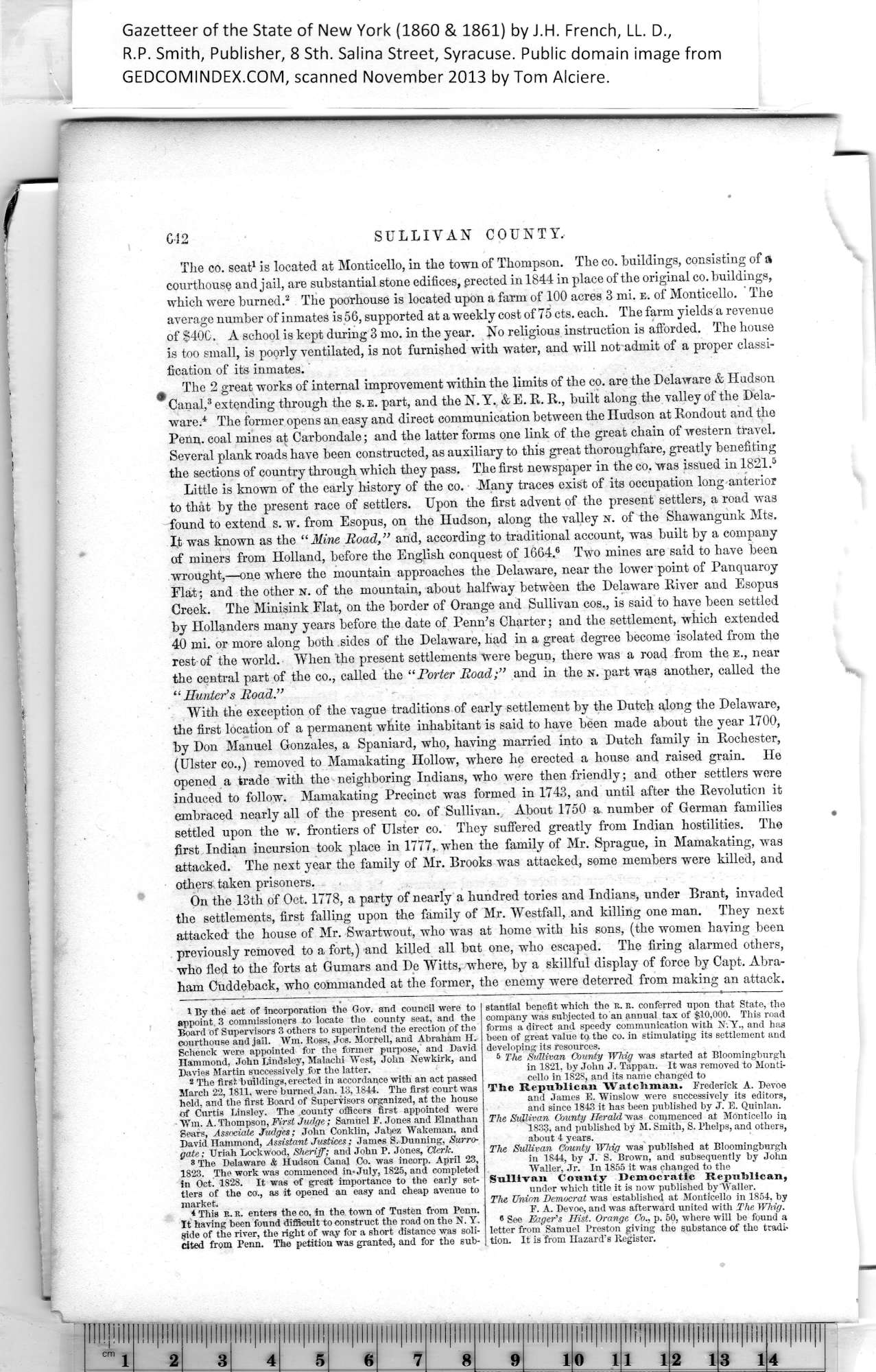|
C-12 SULLIVAN COUNTY.
The co. seat1 is located at Monticello, in the town of Thompson. The co. buildings, consisting of a
courthouse and jail, are substantial stone edifices, greeted in 1844 in place of the original co. buildings,
which were burned.2 The poorhouse is located upon a farm of 100 acres 3 mi. e. of Monticello. The
average number of inmates is 56, supported at a weekly cost of 75 cts. each. The farm yields a revenue
of $400. A school is kept during 3 mo. in the year. No religious instruction is afforded. The house
is too small, is poorly ventilated, is not furnished with water, and will nok admit of a proper classi¬
fication of its inmates.
The 2 great works of internal improvement within the limits of the co. are the Delaware & Hudson
Canal,3 extending through the s. e. part, and the N. Y. & E. 11. R., built along the valley of the Dela¬
ware.4 The former opens an easy and direct communication between the Hudson at Rondout and the
Penn, coal mines at Carbondale; and the latter forms one link of the great chain of western travel.
Several plank roads have been constructed, as auxiliary to this great thoroughfare, greatly benefiting
the sections of country through which they pass. The first newspaper in the co. was issued in 1821.4
Little is known of the early history of the co. Many traces exist of its occupation long anterior
to that by the present race of settlers. Upon the first advent of the present settlers, a road was
found to extend s. w. from Esopus, on the Hudson, along the valley n. of the Shawangunk Mts.
It was known as the “Mine Road,” and, according to traditional account, was built by a company
of miners from Holland, before the English conquest of 1664.® Two mines are said to have been
wrought,—one where the mountain approaches the Delaware, near the lower point of Panquaroy
Flat; and the other n. of the mountain, about halfway between the Delaware River and Esopus
Creek. The Minisink Flat, on the border of Orange and Sullivan cos., is said to have been settled
by Hollanders many years before the date of Penn’s Charter; and the settlement, which extended
40 mi. or more along both sides of the Delaware, had in a great degree become isolated from the
rest of the world. When the present settlements were begun, there was a road from the e., near
the central part of the co., called the “Porter Road;” and in the n. part was another, called the
“ Hunter’s Road.”
With the exception of the vague traditions of early settlement by the Dutch along the Delaware,
the first location of a permanent white inhabitant is said to have been made about the year 1700,
by Don Manuel Gonzales, a Spaniard, who, having married into a Dutch family in Rochester,
(Ulster co.,) removed to Mamakating Hollow, where he erected a house and raised grain. He
opened a trade with the neighboring Indians, who were then friendly; and other settlers were
induced to follow. Mamakating Precinct was formed in 1743, and until after the Revolution it
embraced nearly all of the present co. of Sullivan. About 1750 a number of German families
settled upon the w. frontiers of Ulster co. They suffered greatly from Indian hostilities. The
first Indian incursion took place in 1777,. when the family of Mr. Sprague, in Mamakating, was
attacked. The next year the family of Mr. Brooks was attacked, some members were killed, and
others taken prisoners.
On the 13th of Oct. 1778, a party of nearly a hundred tories and Indians, under Brant, invaded
the settlements, first falling upon the family of Mr. Westfall, and killing one man. They next
attacked the house of Mr. Swartwout, who was at home with his sons, (the women having been
previously removed to a fort,) and killed all but one, who escaped. The firing alarmed others,
who fled to the forts at Gumars and De Witts, where, by a skillful display of force by Capt. Abra¬
ham Cuddeback, who commanded at the former, the enemy were deterred from making an attack.
|
stantial benefit which the r. r. conferred upon that State, the
company was subjected to an annual tax of $10,000. This road
forms a direct and speedy communication with N. Y., and has
been of great value to the co. in stimulating its settlement and
developing its resources.
6 The Sullivan County Whig was started at Bloomingburgh
in 1821, by John J. Tappan. It was removed to Monti¬
cello in 1828, and its name changed to
The Republican Watchman. Frederick A. Devoe
and James E. Winslow were successively its editors,
and since 1843 it has been published by J. E. Quinlan.
The Sullivan County Herald was commenced at Monticello in
1833, and published by M. Smith, S. Phelps, and others,
about 4 years.
The Sullivan County Whig was published at Bloomingburgh
in 1S44, by J. S. Brown, and subsequently by John
Waller, Jr. In 1855 it was changed to the
Sullivan County Democratic Republican,
under which title it is now published by Waller.
The Union Democrat was established at Monticello in 1854, by
F. A. Devoe, and was afterward united with The Whig.
6 See Eager's Hist. Orange Co., p. 50, where will be found a
letter from Samuel Preston giving the substance of the tradi¬
tion. It is from Hazard’s Register. |
1
By the act of incorporation the Gov. and council were to
2
appoint 3 commissioners to locate tho county seat, and the
3
Board of Supervisors 3 others to superintend the erection of the
4
Schenck were appointed for the former purpose, and David
|
